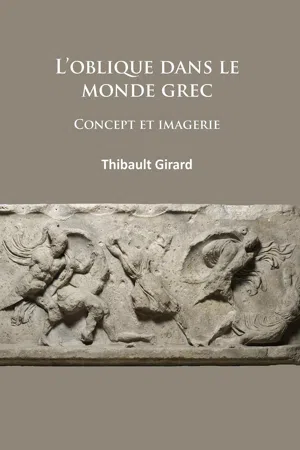
- 193 pages
- French
- PDF
- Disponible sur iOS et Android
À propos de ce livre
What could be more evident than the concepts of oblique, horizontal or vertical? In the modern world, these concepts form the basis of our thought system, both from a mathematical and artistic point of view. Everything would suggest that these principles were known to the Greek civilization. However, the study of the surviving texts casts a different light on the matter. Homer did not know the concept of oblique - no word could translate it into the language of his time. Even later, the Greeks had five adjectives approximately meaning oblique: ?????, ???????, ???????, ??????? and ???????. Each discipline (cosmology, optic, geography, art, etc.) had its own way of looking at these five words. Paradoxically, what the written language had not yet synthesized was abundant in imagery. Even more surprising, the oblique in images, which we consider as a sign of movement in our own iconographic language, is found to signify both movement and rest. Two monuments of Greek art draw attention to this new paradox: the frieze of the Mausoleum of Halicarnassus and the Mourning Athena. In each of them, the oblique line is present, and carries two distinct meanings. These two forms of language, written and figurative, bring a different and complementary perspective on the ancient Greeks' apprehension (or lack thereof) of the concept of oblique.
Foire aux questions
- Essentiel est idéal pour les apprenants et professionnels qui aiment explorer un large éventail de sujets. Accédez à la Bibliothèque Essentielle avec plus de 800 000 titres fiables et best-sellers en business, développement personnel et sciences humaines. Comprend un temps de lecture illimité et une voix standard pour la fonction Écouter.
- Intégral: Parfait pour les apprenants avancés et les chercheurs qui ont besoin d’un accès complet et sans restriction. Débloquez plus de 1,4 million de livres dans des centaines de sujets, y compris des titres académiques et spécialisés. Le forfait Intégral inclut également des fonctionnalités avancées comme la fonctionnalité Écouter Premium et Research Assistant.
Veuillez noter que nous ne pouvons pas prendre en charge les appareils fonctionnant sous iOS 13 ou Android 7 ou versions antérieures. En savoir plus sur l’utilisation de l’application.
Informations
Table des matières
- Cover
- Title Page
- Copyright Page
- Table des Matièes
- Remerciements
- Les Grecs et Nous
- Première Partie: L’oblique dans la pensée grecque
- Chapitre I: Prolégomènes. La table des opposés « fondamentaux » et Homère
- Chapitre II: Macrocosme et microcosme. des présocratiques à Poclos
- Chapitre III: La théorie des atomes. épicure et Lucrèce
- Chapitre IV: L’oblique des vents
- Chapitre V: Strabon
- Chapitre VI: Hippocrate et les médecins grecs
- Chapitre VII: Les Tragiques et les poètes hellénistique
- Chapitre VIII: Le rayon et le miroir : la vision d’euclide
- Trait d’union
- Deuxième partie: L’oblique dans l’art grec
- Chapitre IX: La notion doblique dans l’art
- Chapitre XI: oblique en repos
- Conclusion: Les descriptions atiques doeuvres d’art
- Aabréviations
- Bibliographie
- Index des auteurs anciens
- Index des collections publiques t privées des monuments antique
- Liste des illustrations t crédits photographiques